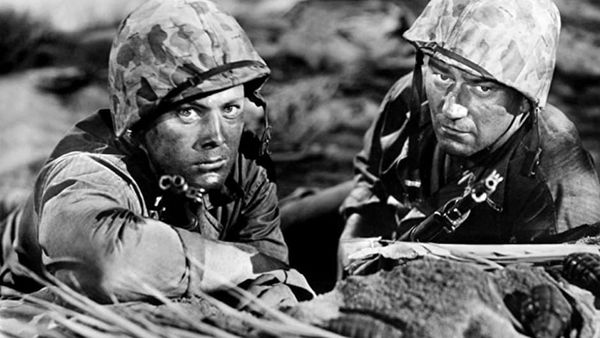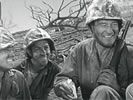Eye For Film >> Movies >> Sands Of Iwo Jima (1949) Film Review

The battle of Iwo Jima was one of the hardest and most brutal of the Second World War Pacific campaign, but gained a unique place in the iconography of America when the Stars and Stripes was raised on Mount Suribachi, the highest point of the island.
The fighting was by no means over, but the image of a foreign flag being raised in battle for the first time on what was technically Japanese soil seemed to symbolise the triumph of democracy and liberation over tyranny and enslavement. The moment, and the battle as a whole has never ceased to resonate in America’s consciousness, from post-9/11 images of firemen raising the flag in the ruins of the World Trade Centre, to Bob Dylan’s song The Ballad of Ira Hayes, about one of the three surviving flag-raisers, a Native American, who encountered prejudice and hostility as well as hero-worship after the war.

And, of course, there is Clint Eastwood’s memorable diptych, Flags Of Our Fathers and Letters From Iwo Jima, which recorded the battle from both perspectives in a downbeat, grimly realistic fashion. But long before that, there was Sands Of Iwo Jima, made soon after the war and making extensive usage of archive film from the actual battle. It gained John Wayne his first Oscar nomination and was a TV staple throughout my childhood. But after all this time, how does it stand up as a movie – and as a document of American history?
Better than you might expect on both counts, is the answer. Yes, it’s undeniably gung-ho and corny at times, the archive footages only emphasises the studio-bound look of the rest of the film, and the Japanese are never more than invisible destroyers or screaming ‘yellow devils’. But the characters are more than mere stereotypes and it has an insight and appreciation of the realities of war that might surprise you – but shouldn’t, given that for the people making this film the Second World War was a recent and painful memory.
The heart of the film is, of course, Wayne’s Sergeant Stryker – a career soldier charged with licking squads of new recruits into shape. He’s already survived the battle of Guadalcanal (the first step in the ‘island-hopping’ war that liberated Japan’s conquered territories and brought American forces to the outlying islands of Japan itself) and knows how hard this kind of war can be – and how only training and discipline will keep his men alive.
It’s a role that in many ways defined the Wayne image – after an early career playing rough and often morally shady types (even Ringo in Stagecoach is an outlaw on the run) Stryker is an embodiment of hard but fair integrity, willing to be disliked if it helps the men under his wing to survive. Even here, though, there’s an attempt to create a character that’s more than a two-dimensional embodiment of heroism. Stryker is estranged from his wife and son because of his commitment to the Marines, and blots out the loneliness with drinking bouts that have seen him busted down from Sergeant-Major. A scene where he goes back to the house of a bar ‘hostess’ who’s struggling to raise a young son on her own, is understated and poignant.
But on duty, he rides the men hard, and the new recruits don’t like it, despite the assurances from fellow veteran Corporal Thomas (Forrest Tucker) that they’ll thank Stryker for it in the end. A particular thorn in Stryker’s flesh is Conway (John Agar), scion of a family that’s produced generations of Marines, including his father, Stryker’s former commanding officer, an old school warhorse who was convinced his son ‘didn’t have what it takes’.
Conway has volunteered for the Marines deliberately to prove him wrong, and he responds well to the training. But he refuses Stryker’s overtures of friendship, constantly insisting that "the Marines way isn’t the only way". This surrogate father-son relationship develops as the training continues; Conway meets a girl (Adele Mara) while on leave in New Zealand and they marry after a whirlwind courtship. But soon after the squad is shipped out to see action for the first time, in the battle to take Tarawa.
This arrives late in the film, and really Sands Of Iwo Jima is as much about the strange, dislocated reality of a soldier’s life in between battles – monotonous duty and training punctuated by bouts of riotous leave and constant waiting in a climate beset by rumours. When the action comes it’s like a coiled spring being unleashed – Dwan’s career stretched back to the silent era and he knew how to stage a battle scene.
But the climax is Iwo Jima itself. Yes, it’s flag-waving (literally) and in its way a part of the propaganda drive that’s the subject of Flags of Our Fathers. The Japanese conveniently stop shooting and generally turn the sound down at crucial moments and the effect is sentimental and manipulative.
Many parts of the film are like this, but not all of it. The seeming pointlessness of a war that consists of taking one identical lump of rock after another is vividly evoked ("trading men for real estate", as one character puts it) and the actors look the part – many of them were real Marines. But ironically, it’s Wayne himself (who never served in the military, and originally turned down the role because he thought the American public had had enough of war pictures) who symbolises the point of the film – that these men weren’t perfect and maybe what they were fighting for wasn’t either. But the alternative was worse and the only way to stop it was to show courage and discipline.
It was the first step on Wayne’s journey to becoming an American icon. And though John Ford and Howard Hawks exploited his dark side better, Dwan deserves credit for realising his strengths as an actor and playing to them. And he and the writers produced a heartfelt, enduring story of men in combat that, for all its flaws, still packs a punch.
Reviewed on: 09 Jun 2008

















